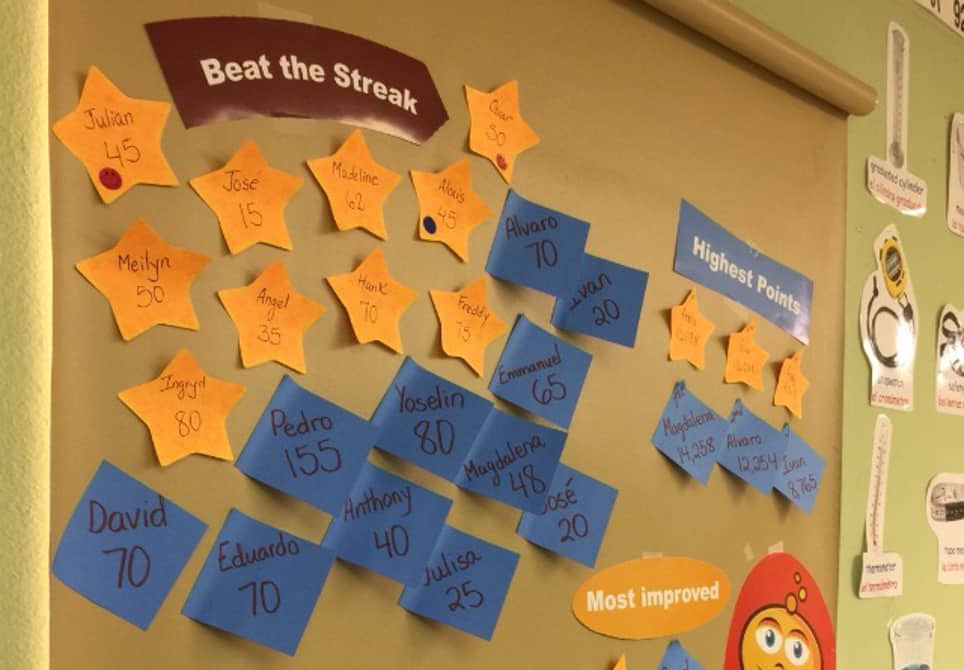Leaderboards: Learning Lessons From Research & Gamification

This is the 4th in a series on the use of leaderboards and other strategies to encourage students to reflect on their performance.
Do we face “A future where everything we do is tracked and quantified: calories, air quality, sleep, heart rate, microbes, brain waves, finances, happiness, sadness…hopes and dreams?” Rose Eveleth, a podcaster that focuses on future scenarios and planning, explored the future of the quantified self in a recent podcast.
Opt-In Competition
“Competition tends to affect some students differently than others–some thrive on it, others don’t,” said Eduardo Briceno, CEO of Mindset Works. Briceno thinks boys tend to react better to it than girls and, for this reason he thinks a voluntary leaderboard is less risky than a compulsory one.
In the informal learning space, FIRST Robotics hosts competitions that teach:
- Gracious Professionalism: Learn and compete like crazy, but treat one another with respect and kindness in the process. Knowledge, competition, and empathy are comfortably blended.
- Coopertition® Produces Innovation: Teams can and should help and cooperate with each other even as they compete.
These competitions allow the participants to choose to join the process and benefit from the results. If they are not actively motivated by this process, they can self-select out.
Promote Growth
From the growth mindset lens, leaderboards can be tricky. “The more we compare people to one another, the more it tends to put people in a fixed mindset as opposed to comparing people to themselves,” added Briceno.
“A leaderboard that measured progress (e.g., standards/levels achieved), or learning-oriented behaviors (e.g., asking questions, sharing mistakes to discuss lessons learned) rather than absolute mastery would foster more of a growth mindset because it would encourage a focus on things learners have more control over in the shorter term (their behaviors and how much progress they make). It could also be used to encourage discussions on learning strategies so learners could share what strategies are working better for them to make greater progress.
“Making personal progress visible to the learner is always a great growth mindset strategy. In more trusting environments (where culture has been developed as a trusting culture) that can be more public, so learners can support one another and share what’s working versus not,” said Briceno.
A Blackstone Valley Prep teacher wasn’t getting the most of Khan Academy until he started printing and posting daily scores and highlighting the daily leaders, which spurred the principal to come into the room and give high-fives and congratulations to each daily winner. Shawn Rubin, Highlander Institute, thinks it was powerful “because it was based on effort and number of lessons conquered and not on percentage correct or mastery. These reports were taken down and put up daily so kids started fresh each day.”
Track Cohorts
Venture investor, Sean O’Sullivan, questions, “Won’t we get better engagement when we put users in context with their peers? Leaderboards personalize our users’ achievements in ways that help them compete or see how they are doing versus each other, and potentially also match ‘play’ against each other.” O’Sullivan does contend that if a leaderboard only surfaces the same leaders each week, then part of the benefits of the social network effect of getting one user to engage directly with another is defeated. O’Sullivan states that “laggard boards” or “cohort boards” are the new leaderboards. A “cohort board” would show a new user compared to others who are new, perhaps those that have not yet cracked an achievement
Briceno states, “I’d hypothesize that leaderboards that aggregate a class or a school progress, and compare it to some other class or school, could be motivating and growth mindset oriented. It could put everyone in the class/school on the same page and in the same team to work with one another to help one another identify and adopt better learning strategies to accelerate aggregate team progress. That’s just speculation though, I haven’t seen research on that.”
There is a growing body of evidence to support leaderboards in various environments. More research needs to be done in educational settings, but for now, there is promise in using the gamification process to support student engagement and academic growth.
Have advice on leaderboards or performance monitoring? Questions? Examples? We’d love to hear from you. Comment below or email our [email protected].
For more, see:
- Reflecting on Performance
- Reasoning Minds Deserve Thoughtful Progress Monitoring
- To Leaderboard or Not: The Art of Motivating and Monitoring Performance
Stay in-the-know with all things EdTech and innovations in learning by signing up to receive the weekly Smart Update.







0 Comments
Leave a Comment
Your email address will not be published. All fields are required.